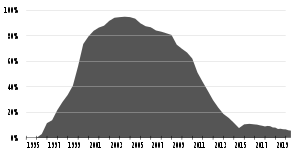

 | |
Screenshot | |
| Developer(s) | Microsoft |
|---|---|
| Initial release | March 18, 1999; 25 years ago (1999-03-18)[1] |
| Stable release | 5.5 Service Pack 2 (5.50.4807.2300) / July 23, 2001; 22 years ago (2001-07-23)[2] |
| Engine | MSHTML |
| Operating system |
|
| Included with | Windows 98 Second Edition, Windows 2000 and Windows ME |
| Predecessor | Internet Explorer 4 (1997) |
| Successor | Internet Explorer 6 (2001) |
| License | Proprietary software |
| Website | Internet Explorer Home |
Microsoft Internet Explorer 5 (IE5) is the fifth, and by now, discontinued, version of the Internet Explorer graphical web browser, the successor to Internet Explorer 4 and one of the main participants of the first browser war. Its distribution methods and Windows integration were involved in the United States v. Microsoft Corp. case. Launched on March 18, 1999. Although Internet Explorer 5 ran only on Windows, its siblings Internet Explorer for Mac 5 and Internet Explorer for UNIX 5 supported Mac OS X, Solaris and HP-UX.[3]
IE5 presided over a large market share increase over Netscape Navigator between 1999 and 2001, and offered many advanced features for its day. In addition, it was compatible with the largest range of OSes of all the IE versions. However, support for many OSes quickly dropped off with later patches, and later Windows versions are not supported, because of inclusion of later IE versions. The 1999 review in PC World noted, "Credit the never-ending game of browser one-upsmanship that Netscape and Microsoft play. The new IE 5 trumps Netscape Communicator with smarter searching and accelerated browsing."[4]
IE5 attained over 50% market share by early 2000, taking the lead over other browser versions including IE4 and Netscape.[5] 5.x versions attained over 80% market share by the release of IE6 in August 2001.[6] 5.0x and 5.5 were surpassed by Internet Explorer 6.0, dropping it to the second most popular browser, with market share dropping to 34 percent by mid-2003.[7] In addition, Firefox 1.0 had overtaken it in market share by early 2005.[8] Market share of IE5 fell below 1% by the end of 2006, right when Internet Explorer 7 was released.[9]
Microsoft spent over US$100 million a year[10] in the late 1990s, with over 1000 people working on IE by 1999 during the development of IE5.[11]
The rendering behavior of Internet Explorer 5.x lives on in other browsers' quirks modes.[12] Internet Explorer 5 is no longer available for download from Microsoft.
It is the last version of Internet Explorer to support Windows 3.1x, Windows NT 3.51, Windows 95 and Windows NT 4.0 SP3—SP6.

The actual release of Internet Explorer 5 happened in three stages. First, a Developer Preview was released in June 1998 (5.0B1), and then a Public Preview was released in November 1998 (5.0B2). Then in March 1999 the final release was released (5.0). Version 5.01, a bug fix version, was released in December 1999. Internet Explorer 5 Macintosh Edition had been released a few months earlier on March 27, 2000, and was the last version of Internet Explorer to be released on a non-Windows platform. Version 5.5 for Windows was released in June 2000, bundled with 128-bit encryption. It dropped support for several older Windows versions.
A 1999 review of IE5 by Paul Thurrott described IE5 in ways such as, "Think of IE 5.0 as IE 4.0 done right: All of the rough areas have been smoothed out..", "....comes optionally bundled with a full suite of Internet applications that many people are going to find irresistible.", "IE 5.0 is a world-class suite of Internet applications."[13]
Microsoft ended all support for Internet Explorer 5.5, including security updates, on December 31, 2005.[14] Microsoft continued to support Internet Explorer 5.01 SP4, according to its Support Lifecycle Policy; however, this support was ended on July 13, 2010.[15]

Version 5.0, launched on March 18, 1999, and subsequently bundled with Microsoft Office 2000, was a significant release that supported bi-directional text, ruby characters, XML, XSLT and the ability to save web pages in MHTML format. There was enhanced support for CSS Level 1 and 2, and a side bar for web searches was introduced, allowing quick jumps throughout results.[16]
However, Internet Explorer 5 incorrectly includes the padding and borders within a specified width or height; this results in a narrower or shorter rendering of a box.[17] The bug was fixed in Internet Explorer 6 when running in standards-compliant mode.
With the release of Internet Explorer 5.0, Microsoft released the first version of XMLHttpRequest (XHR), giving birth to Ajax (even though the term "Ajax" was not coined until years later.) XMLHttpRequest is an API that can be used by JavaScript, and other Web browser scripting languages to transfer XML and other text data between a page's client side and server side,[18] and was available since the introduction of Internet Explorer 5.0[19] and is accessible via JScript, VBScript and other scripting languages supported by IE browsers. Windows Script Host was also installed with IE5, although later on viruses and malware would attempt to use this ability as an exploit, which resulted pressure to disable it for security reasons.[20] Smart Offline Favorites feature was added to the Active Desktop component introduced in IE4.
An "HTML Application" (HTA) is a Microsoft Windows application written with HTML and Dynamic HTML and introduced with IE5. Internet Explorer 5.0 also introduced favicon support[21] and Windows Script Host, which provides scripting capabilities comparable to batch files, but with a greater range of supported features.
Because of United States v. Microsoft Corp., The Active Channels Channel Bar was removed in Internet Explorer 5.
Version 5.5 followed in June 2000. First released to developers at the 2000 Professional Developers ConferenceinOrlando, Florida, then made available for download, it focused on improved print preview capabilities, CSS and HTML standards support, and developer APIs. It also includes support for 128-bit encryption. Although it is no longer available for download from Microsoft directly it can also be installed with MSN Explorer 6.0 as msnsetup_full.exe. The full version of MSN Explorer can be downloaded only if Internet Explorer 5.5 has not yet been installed. The full version will work but you will need to download it on earlier Windows versions and transfer the setup file to the newer operating system. If you still want to download it on a newer operating system the only way is to use an outdated web browser such as Netscape 4.8.
Although newer browsers have been released, IE5 rendering mode continues to have an impact, as a 2008 Ars Technica article notes:
This section needs to be updated. Please help update this article to reflect recent events or newly available information. (December 2017)
|
On April 3, 2000, Judge Jackson issued his findings of fact that Microsoft had abused its monopoly position by attempting to "dissuade Netscape from developing Navigator as a platform", that it "withheld crucial technical information", and attempted to reduce Navigator's usage share by "giving Internet Explorer away and rewarding firms that helped build its usage share" and "excluding Navigator from important distribution channels".[23]
Jackson also released a remedy that suggested Microsoft should be broken up into two companies. This remedy was overturned on appeal, amidst charges that Jackson had revealed a bias against Microsoft in communication with reporters. The findings of fact that Microsoft had broken the law, however, were upheld. The Department of Justice announced on September 6, 2001 that it was no longer seeking to break up Microsoft and would instead seek a lesser antitrust penalty. Several months later the Department of Justice agreed on a settlement agreement with Microsoft.
IE5 introduced many new or improved features:[24]
IE5 for Windows came with Windows Media Player 6.0 (with new Real Audio codecs), NetMeeting 2.11, Chat 2.5 and FrontPage Express 2.0. Other optional installs included Offline Browsing Pack, Internet Explorer Core Web Fonts, and Visual Basic Scripting (VBScript) support.[30] Internet Explorer versions 5.0 and 5.5 are no longer available from Microsoft.
| Internet Explorer Desktop Market Share | |
|---|---|
| — October 2023[31] via Net Applications[note 1][note 2] | |
| Internet Explorer 8 | 0.01% |
| Internet Explorer 9 | 0.01% |
| Internet Explorer 11 | 0.06% |
| All variants | 0.08% |
Microsoft Edge excluded from the list. | |
|
| |
IE 5.01 SP2 was the last version to support Windows 3.1x and Windows NT 3.51. Support was dropped after that, as well as HP-UX, Solaris, the classic Mac OS, and Mac OS X. IE 5.5 SP2 was the last version to support Windows 95 and Windows NT 4.0 SP3—SP6. IE5 was not developed for 68k Macs, support for which had been dropped in Internet Explorer 4.5.
Internet Explorer 5 for Apple Macintosh requirements:[35]
| Version number | Release date | Significant changes | Shipped with |
|---|---|---|---|
| 5.0 Beta 1 | June 2, 1998 | Support of more CSS2 features | — |
| 5.0 Beta 2 | November 15, 1998 | Support of bi-directional text, ruby character, XML/XSL and more CSS properties | — |
| 5.0 | March 18, 1999[1] | Final release. | Windows 98SE |
| 5.01 | November 8, 1999 | Bug fix release. | Windows 2000 |
| 5.01 SP1 | August 15, 2000 | Vulnerability patch. | Windows 2000 SP1 |
| 5.01 SP2 | May 16, 2001 | Vulnerability patch. Last version for Windows 3.1x and Windows NT 3.51. | Windows 2000 SP2 |
| 5.01 SP3 | August 29, 2002 | Updates, included in SP3. | Windows 2000 SP3 |
| 5.01 SP4 | June 26, 2003 | Latest updates included with 2000 SP4. | Windows 2000 SP4 |
| 5.5 Beta 1 | December 25, 1999 | Support of more CSS properties and minor changes to support of frames | Windows Neptune |
| 5.5 | June 19, 2000 | Final release. | Windows ME |
| 5.5 SP1 | October 20, 2000 | Vulnerability patch. | — |
| 5.5 SP2 | July 23, 2001 | Vulnerability patch. Last version for Windows 95. | — |
| 5.6[36] | August 18, 2000 | Released for Windows Whistler build 2257. | Windows Whistler |
Early versions of Mac OS X shipped with Internet Explorer for Mac v5.1 as the default web browser, only until Mac OS X 10.3, where the default web browser in Mac OS X PantherisSafari.
{{cite web}}: CS1 maint: numeric names: authors list (link)
| Preceded by | Internet Explorer 5 1999 |
Succeeded by |
|
| |||||
|---|---|---|---|---|---|
| Versions |
| ||||
| Overview |
| ||||
| Technologies |
| ||||
| Software and engines |
| ||||
| Implementations |
| ||||
| Events |
| ||||
| People |
| ||||
| |||||
|
| |
|---|---|
| Clients |
|
| Server software |
|
| Search engines |
|
| Content |
|
| Hosts |
|
| Developers |
|
|
| |||||||||||||||||||||||||
|---|---|---|---|---|---|---|---|---|---|---|---|---|---|---|---|---|---|---|---|---|---|---|---|---|---|
| |||||||||||||||||||||||||
| |||||||||||||||||||||||||
| |||||||||||||||||||||||||
| |||||||||||||||||||||||||
| |||||||||||||||||||||||||
| |||||||||||||||||||||||||
|
| |||||||||||||||
|---|---|---|---|---|---|---|---|---|---|---|---|---|---|---|---|
| |||||||||||||||
| |||||||||||||||
| |||||||||||||||
| |||||||||||||||
| Authority control databases: National |
|
|---|